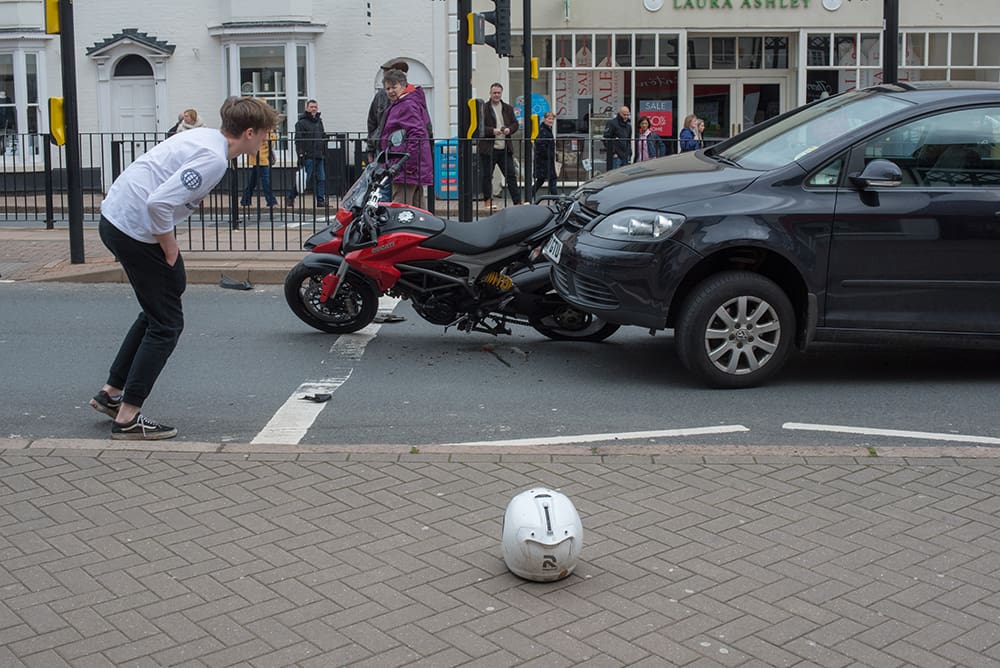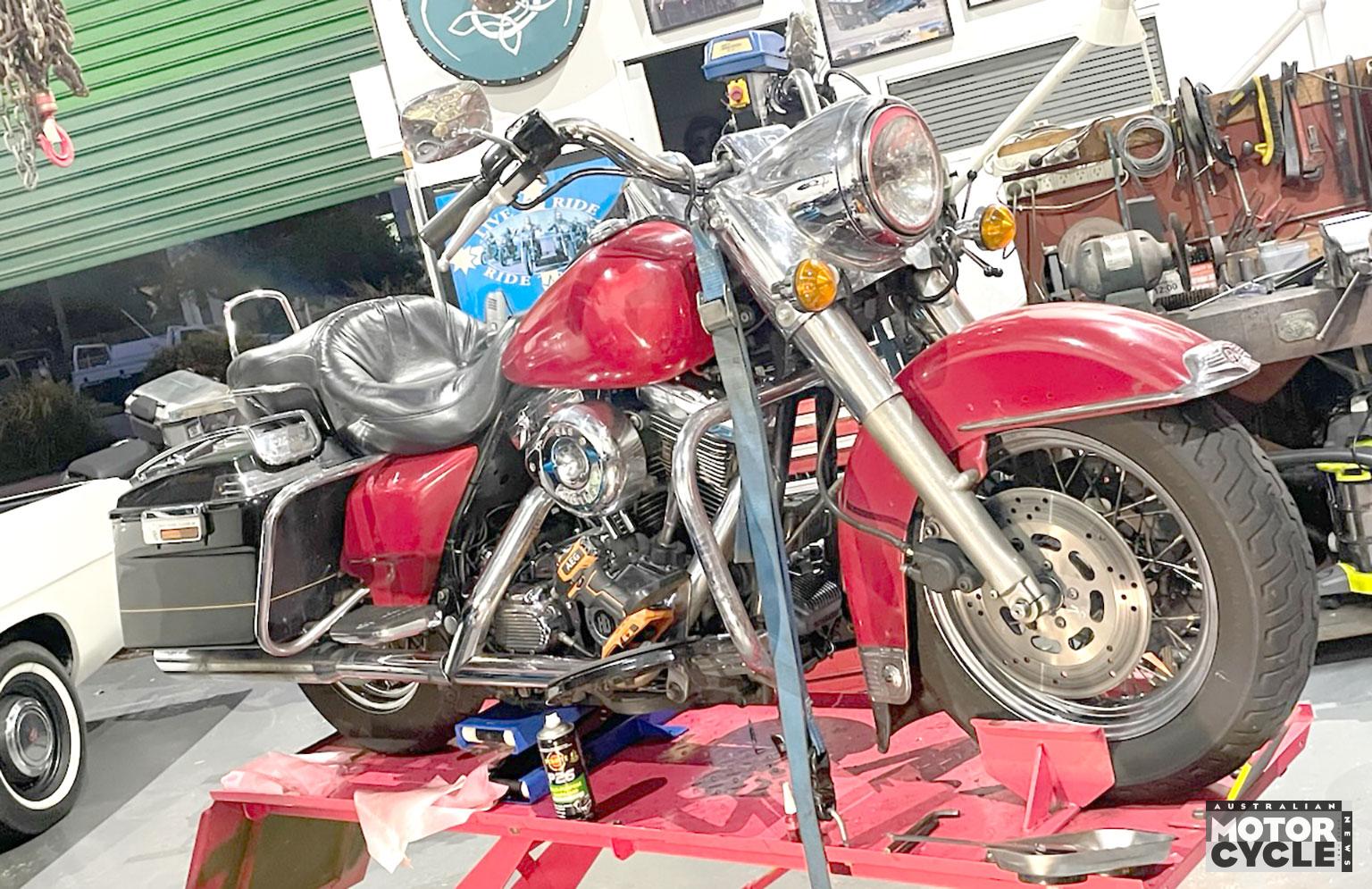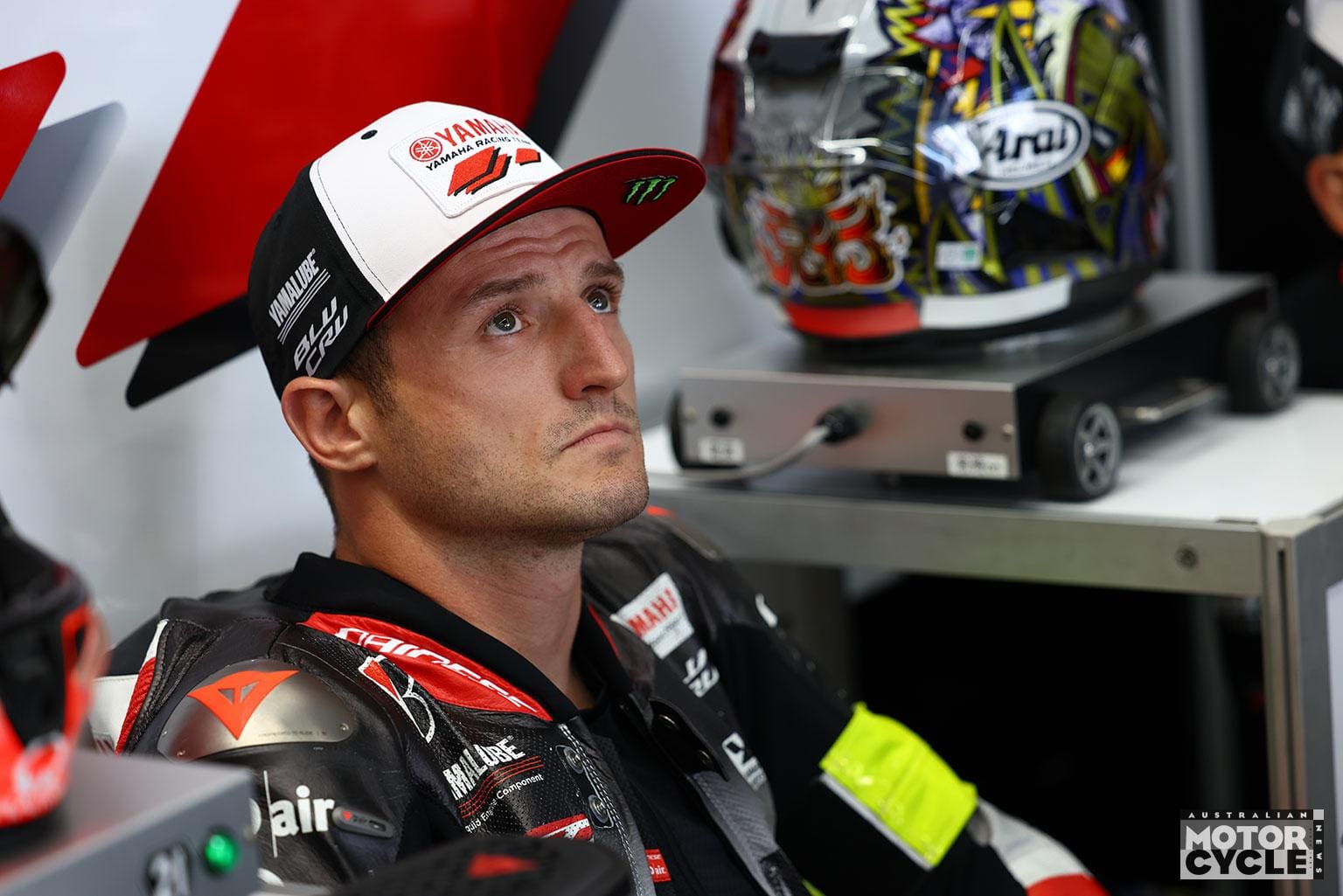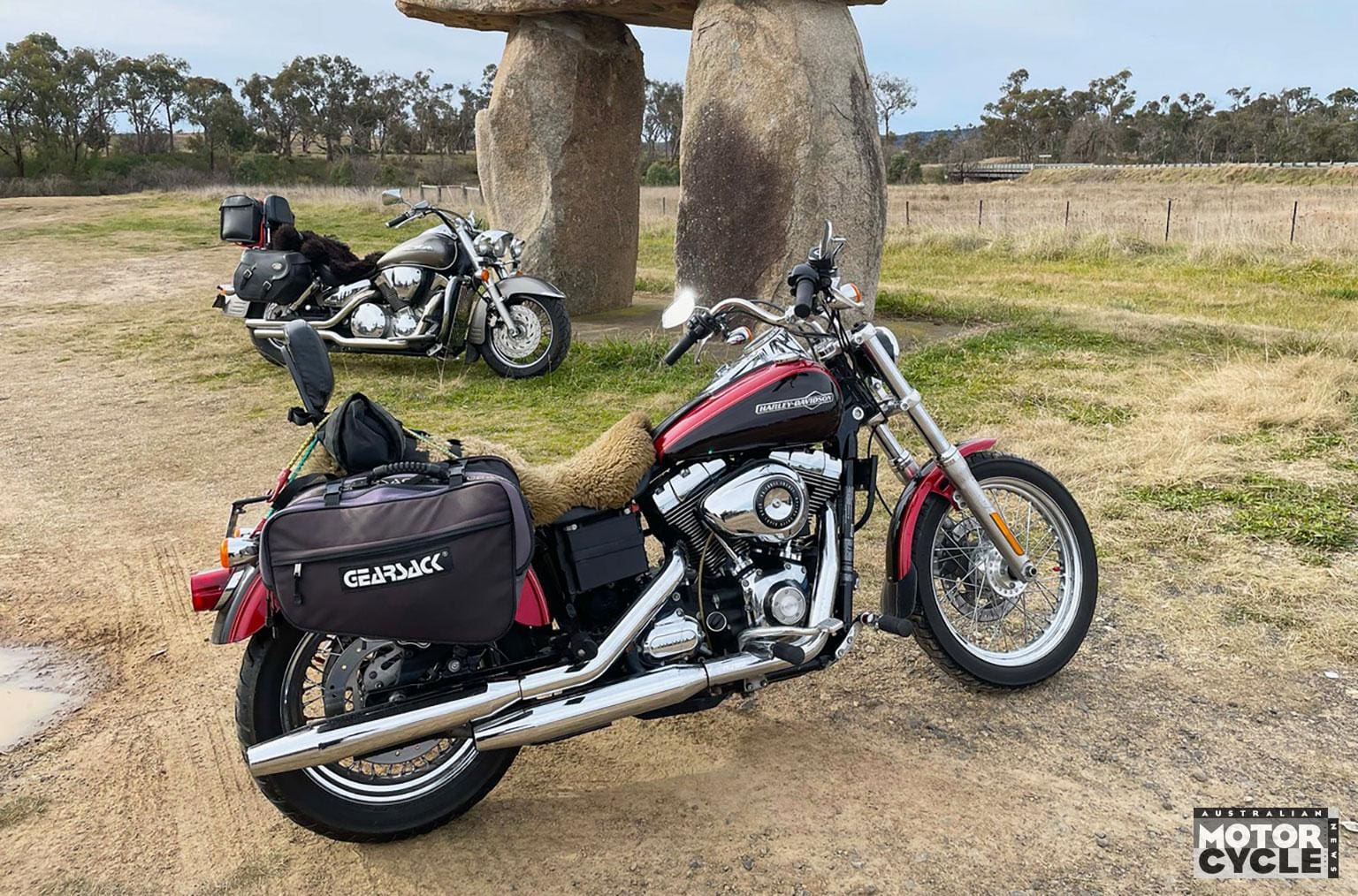Crashing a car is nobody’s idea of a picnic. I’ve had my ribs cracked asunder, lungs seatbelt-smacked to the point where it felt like I was breathing through a needle, and been punched in the face – with tongue-lolling force – by an airbag.
Aside from the smashing shudder of impact, there’s the screeching tyres, the screaming brakes and the squealing humans in the car with you, providing a cacophony of chaos. It’s all pretty shit. And yet I’d happily do it all again, right now, if the only other option was crashing a motorcycle.
It’s the burning that sticks with me, as the predominant pain point. The skid of skin on leather on road, and on fire, seemingly. The fear factor is also worse, I’m afraid. That long, cruelly drawn out mini-moment, a nanosecond that moves at Nanna speed in your mind, when you know you’re about to have an accident, and you brace yourself for it physically as your brain fades to hot white flashes of ‘Oh shit, Oh shit, Oh shit’.
Crashing is, in the minds of the weak and watery, a justification on its own for not riding. Indeed, after a few unbelievably close shaves and painful impacts, almost none of which were technically my fault, I gave up riding for a while. I even kept a piece of gravel in my back from the last blood-slide along a road, to remind me, but it didn’t last.
The fact is, of course, there’s a chance we’ll all fall off at some point in our riding careers. Tied to that is the claim from some that they’ve never fallen off or never had a crash that wasn’t the fault of someone else; invariably someone else in a car.
But is that truism true? Are most motorcycle accidents caused by inattentive phone addicts in their overly quiet, comfortable and stultifyingly safe SUVs? How much responsibility do we, as riders, have for the relatively high number of bike crashes on our roads? Even if it was legally and technically someone else’s fault, if we crash at all, it’s our fault, right? Why is that we never seem to want to admit that?
Crashing is, truly, the C word. Using it, even in impolite company, is frowned upon.
So, what do the cold, hard and occasionally bloody facts tell us?
First, some good news – rider deaths are actually decreasing across Australia. It’s not the huge fall we’d all like to see – it’s a 10 percent drop over 10 years, according to the Australian Road Deaths database – but it is sustained. And it becomes even better news when you consider motorcycle registrations across the country increased by more than a third over the same period.
According to the Australian Bureau of Statistics, Australians registered 200,000 additional motorbikes between 2008 and 2018, with registrations up from 567,569 in 2008 to 860,700 in 2018. That equates to an increase of more than 34 percent in motorcycle ownership, yet 10 percent fewer deaths.
There were 245 biking fatalities among 567,000 riders in 2008, versus 192 among 860,000 riders in 2018. Over the past 10 years, on a purely statistical basis, the chances of an Australian biker owning the motorcycle they’ll die on has decreased by more than 51 percent, to little more than 0.02 percent.
That’s a figure to shove in the face of anyone who calls you a Temporary Australian.
Sadly, statistics which show how things are getting better don’t mean all that much when you’re at the funeral of a mate or family member. And, even in numerical terms, it’s hard to celebrate a 10 percent reduction in road fatalities in a decade when, over the same period, car-driver deaths have fallen by 16.4 per cent.
And let’s not forget that we’re still talking about hundreds of bikers dying every year.
Worse still is that, in the 12 months to May 2019, motorcyclist deaths increased over the previous period, according to the Australian Bureau of Infrastructure, Transport and Regional Economics. Sure, statistically we just have bad years now and then, yet over the same period, fatalities for car drivers and their passengers, pedestrians and cyclists all decreased.
Then there’s the ugly, farting elephant in the room; the fact that riders are more likely to die than drivers. This is fact that bears repeating, even if it is as obvious as the suggestion that having 390 million guns in your country makes it more likely that someone will get shot.
So, how bad is it? Well, the Queensland University of Technology’s Centre for Accident Research and Road Safety found that motorcyclists are 30 times more likely to die in an accident than car occupants. According to its 2017 report, “motorcycles accounted for only five percent of Queensland vehicle registrations, yet motorcyclists accounted for 24.8 percent of the state road fatalities.”
Those figures are reflected across Australia – according to Victoria’s Transport Accident Commission (TAC), motorbike riders make up less than four percent of road users in Victoria, but accounted for 18 percent of road deaths over the past 10 years.
And in New South Wales, motorcycles accounted for 4.5 percent of registered vehicles in 2018, according to the Australian Bureau of Statistics, yet Transport NSW figures indicate that motorcyclists accounted for 21 per cent of all hospitalisations in the same year. And recorded serious injuries for motorcyclists have not dropped below 2500 since 2007, when there were 2404.
So, we know that too many riders are being hurt, and too many are dying. We know that we make up a disproportionate part of the national road toll. But what’s the cause? Is it simply the lack of a safety cell, a seatbelt and airbags, or something more?
Anyone who’s ridden through city streets or arterial roads would feel confident pointing the finger at kamikaze cabbies, or distracted, dickheaded tradies. And it feels safe to blame dithering drivers who are less concerned with driving than they are with finding the right track on Spotify.
But the figures just don’t back up the narrative – in NSW, 53 percent of motorcycle fatalities in 2017, and 51 percent in 2018, were caused by single-vehicle crashes. That’s one bike, and no cars at all.
So far this year in Victoria, 10 out of the 13 riders who died did so as a result of a single-vehicle accident. QUT’s Centre for Accident Research and Road Safety found that 49 percent of fatal motorbike accidents involved just one bike and its rider. Yes, half is the figure we keep coming back to.
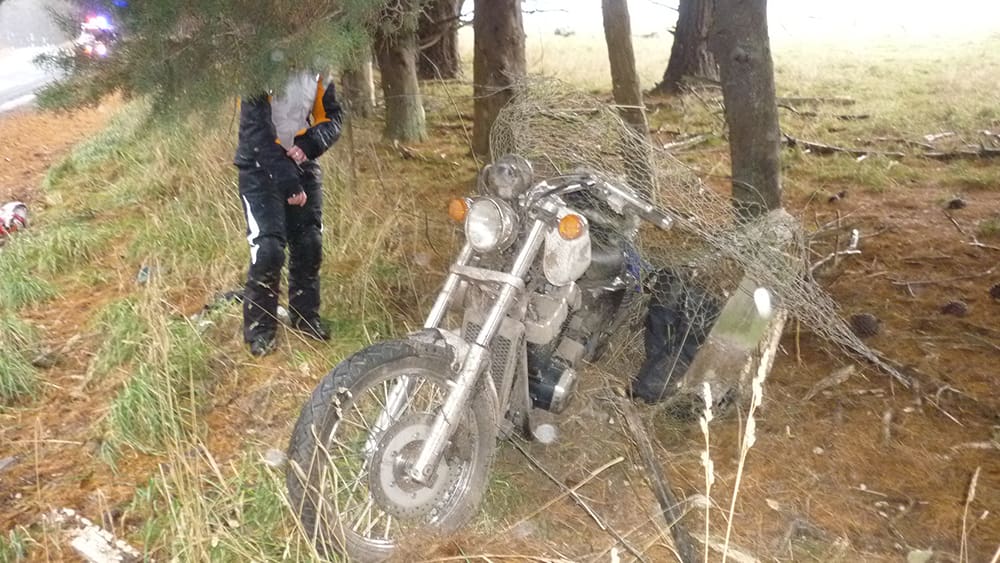
The QUT also found that, in cases where another vehicle was involved, “the motorcyclist [was] deemed to be at fault in just over half [of] these crashes.”
It’s hard to digest figures that suggest that 50 percent of the time, bikers are the architects of their own demise. There’s a cognitive dissonance between how often we save our own skin from the road warriors and raging misanthropes who take lane filtering as a personal insult, and the idea that half the time, they’re not to blame – we are.
Or are we? If we crash our bikes, is it always our fault? What about the myriad other factors besides rider error?
Take the case of a couple who were killed a few years ago in Victoria. According to the coroner, the rider’s bike struck a “substantial bitumen mound” found on the proper cornering line in a “tight left-hand bend”, which “caused [him] to lose control.”
At the time, the rider was travelling at more than the advised corner speed but less than the road’s posted speed limit. A friend of the couple who was riding in convoy, approached the same corner below the advised corner speed and hit the same bump, but did not lose control. Instead, he stopped and tried in vain to save his friends’ lives.
If the pressure ridge wasn’t there, it’s probable that rider and pillion would be alive today. If the rider had entered the corner at the suggested entry speed, it’s also possible he would not have lost control. Finally, if a Nissan Patrol wasn’t coming the other way at that exact moment, there’s every possibility that they might have walked, or at least limped, away from the crash.
That’s the thing about statistics – they can sometimes tell such a small amount of the story. But clearly it wouldn’t hurt if roads were safer?
“Regular maintenance is essential to keep Victoria’s arterial road network in good condition,” says Roger Chao, VicRoads Director, Road User and Vehicle Access. “That’s why we’re rolling out new surveillance officer training to help our crews better identify road imperfections and other potential hazards for motorcyclists.”
But there’s an argument for a wider scope than just road maintenance. “The four elements are safer people, safer roads, safer speeds and safer vehicles,” says Bernard Carlon, Executive Director of the NSW Centre for Road Safety.
“We need to improve the safety of all parts of the system, so that if one part fails, the other parts will protect people from being killed or seriously injured.
“With all of these elements working together as a whole, the system is more forgiving of human or mechanical error and the impact of a mistake made on the road does not result in a fatality or serious injury.”
The first element of Carlon’s approach is safer people. But what does that mean for motorcyclists?
“I’d start with a more stringent learner’s course and a higher level of knowledge to earn L plates,” says a NSW Highway Patrolman, who asked to remain anonymous.
He’s seen fatalities “on a number of occasions” from rudimentary mistakes, like “travelling too close to other vehicles” and “filtering between a car and the kerb”. In situations like these, he says, the rider “hasn’t had time to react.”
In his experience attending motorcycle crashes, and even while pursuing errant riders, a “lack of riding skill is a major factor”. He’s had to call off “an extremely high-speed pursuit” because the person he was chasing “was a shit rider, so I terminated the pursuit for his safety.”
That leads us to the other, passive part of personal protection. Since 1972, helmets have been mandatory inclusions in Australia, but everything else remains merely a strong recommendation. The Consumer Rating and Assessment of Safety Helmets, or CRASH, now rates the protection of helmets, while MotoCAP rates the performance of jackets, pants and gloves.
But there may be an even more basic cause. According to BITRE, male road deaths among all road users have consistently been around three times higher than their female counterparts.
In New South Wales, men make up around 90 percent of motorbike riders, according to Transport NSW. According to VicRoads, Victoria shares that same 90-10 split, male to female.
Blokes are more dangerous on the roads, regardless of what they’re piloting. As a 2003 Queensland study in the snappily titled International Journal of Injury Control and Safety Promotion states, “males scored higher than females in driver aggression and thrill seeking and in their general risk acceptance”, and that “males were twice as likely to have reported at least one crash as a driver compared to females, and nearly three times as likely to have reported two or more crashes.”
So perhaps the simplest answer in all of this – before roads are fixed, before rider training gets better and more widespread, before ABS and traction control are mandatory on motorbikes – is to ask one simple question: “If you do crash, whose responsibility is it really?”
DOES RIDER TRAINING WORK?
You train for your job, or to make a coffee. Does rider training pay off?
Of all the state and federal agencies contacted for this article, none presented hard data on the effect of pre-learner practical training. Transport NSW is “currently evaluating the Motorcycle Graduated Licensing Scheme (MGLS) which includes the pre-learner training course.”
A 2017 motorcycle safety review in Western Australia (where pre-learner training is not a part of getting a motorcycle licence) suggests investigating “the benefits of a competency-based practical riding assessment” and “mandatory or voluntary pre-training.” So far, they’ve noted that “evidence [of benefit] is inconclusive but many jurisdictions have some form of off-road qualification scheme which could be replicated or modified for use in Western Australia.” And the result of WA’s wilful avoidance of sensible policy? Well, despite representing only 5.6 percent of the registered vehicles in WA, 18 percent of its fatalities were motorcyclists last year (29 of them).
Surely it stands to reason that training and practice in both basic and advanced riding techniques could only help. Ask any motorcyclist who also pilots cars occasionally whether they think their training, and experience, on bikes makes them a better driver and you’ll get the same affirmative answer every time. Same goes for whether people learning to drive cars should be getting something similar. And yet skills such as lessons on how to regain traction at the front and rear tyre are not always part of current learner-training programs, where they do exist. They instruct more on the operation of a motorcycle, less on its control, and not on emergency manoeuvres. Further training is left to the inclination and bank balance of the rider.

The amc’s take
Australian Motorcycle Council’s President Guy Stanford says it’s all about managing the risk
“If you’re young, full of your own bullshit and reckon you already know all there is about riding, don’t read this. “Just because you know how to operate the controls of a motorcycle does not mean you’re a safe rider. Learning how not to crash is an internal process that is different for everyone, because we think differently and complete different tasks with different mental skills. “Learning not to crash is about using reason to assess rewards and risks. It’s like growing up. The entire course of life is utterly dependent upon what we think about and how we think about it. But like the logic embedded in computer code, if we start with a false premise, we get a false answer. If you believe that someone or something else is to blame, then you miss the entire point and can become incapable of learning. “It’s up to you. Accepting full responsibility is, for some people, terribly confronting and avoided with shouting. If we treat ourselves kindly and accept personal responsibility as fundamental to our success, then we manage risks well; we see other road users through the same lens and become more accommodating. “Those people who love riding and have the ability and willingness to gain a deeper understanding of the skills involved become better at risk management. They learn what the risks are and how to manage them. “And if we are prepared for a little self-examination, we can learn a lot from watching others. Attending advanced riding courses is an excellent way to break old beliefs, form good habits and learn new tricks on doing it right. “Think about what you learned on your last ride. Nobody ever ‘arrives’ as a motorcyclist, there’s always something else to learn.”
